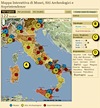Beyond findability
In one of the articles “Beyond Findability“, Luigi Spagnolo, Davide Bolchini, Paolo Paolini and Nicoletta Di Blas introduce Search-Enhanced Information Architecture (SEE-IA), a coherent set of information architecture design strategies.
This paper details a way to extend classic information architecture for web-based applications. The goal is to enhance traditional user experiences, mainly based on navigation or search, to new ones (also relevant for stakeholders’ requirements). Examples are sense making, at a glance understanding, playful exploration, serendipitous browsing, and brand communication. These new experiences are often unmet by current information architecture solutions, which may be stiff and difficult to scale, especially in the case of large or very large websites. A heavy reliance upon search engines seems not to offer a viable solution: it supports, in fact, a limited range of user experiences. We propose to transform (parts of) websites into Rich Internet Applications (RIAs), based, beside other features, upon interaction-rich interfaces and semantic browsing across content. We introduce SEE-IA (SEarch-Enhanced Information Architecture), a coherent set of information architecture design strategies, which innovatively blend and extend IA and search paradigms. The key ingredients of SEE-IA are a seamless combination of structured hypertext-based information architectures, faceted search paradigms, and RIA-enabled visualization techniques. The paper elucidates and codifies these design strategies and their underlying principles, identifying also how they support a set of requirements which are often neglected by most current design approaches. A real case study of a complex RIA designed for a major institutional client in Italy is used to vividly showcase the design strategies and to provide ready-to-use examples that can be transferred to other IA contexts and domains.
Authors Luigi Spagnolo, Paolo Paolini and Nicoletta Di Blas come from the HOC Lab (Hypermedia Open Centre Laboratory) of the Electronic and Information Department of the Politecnico di Milano, whereas Davide Bolchini is based at the School of Informatics of Indiana University – IUPUI.




